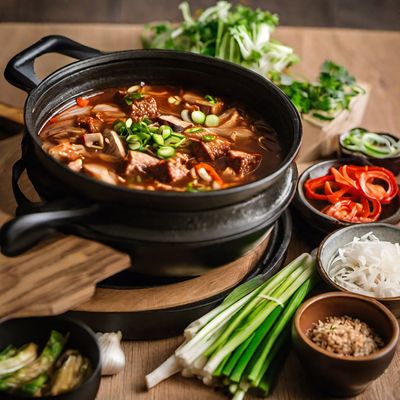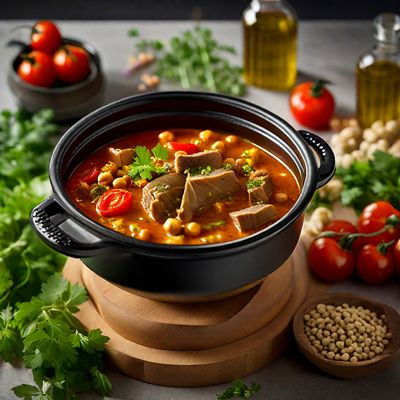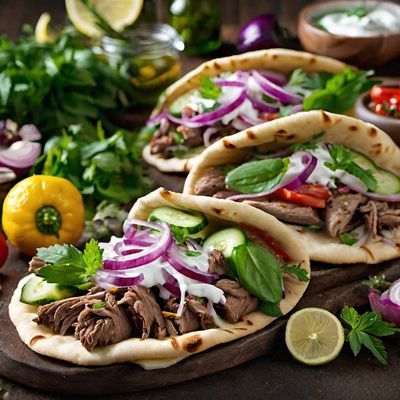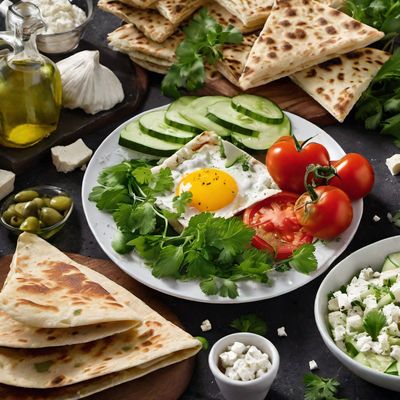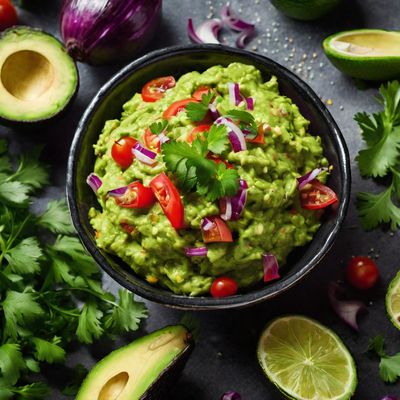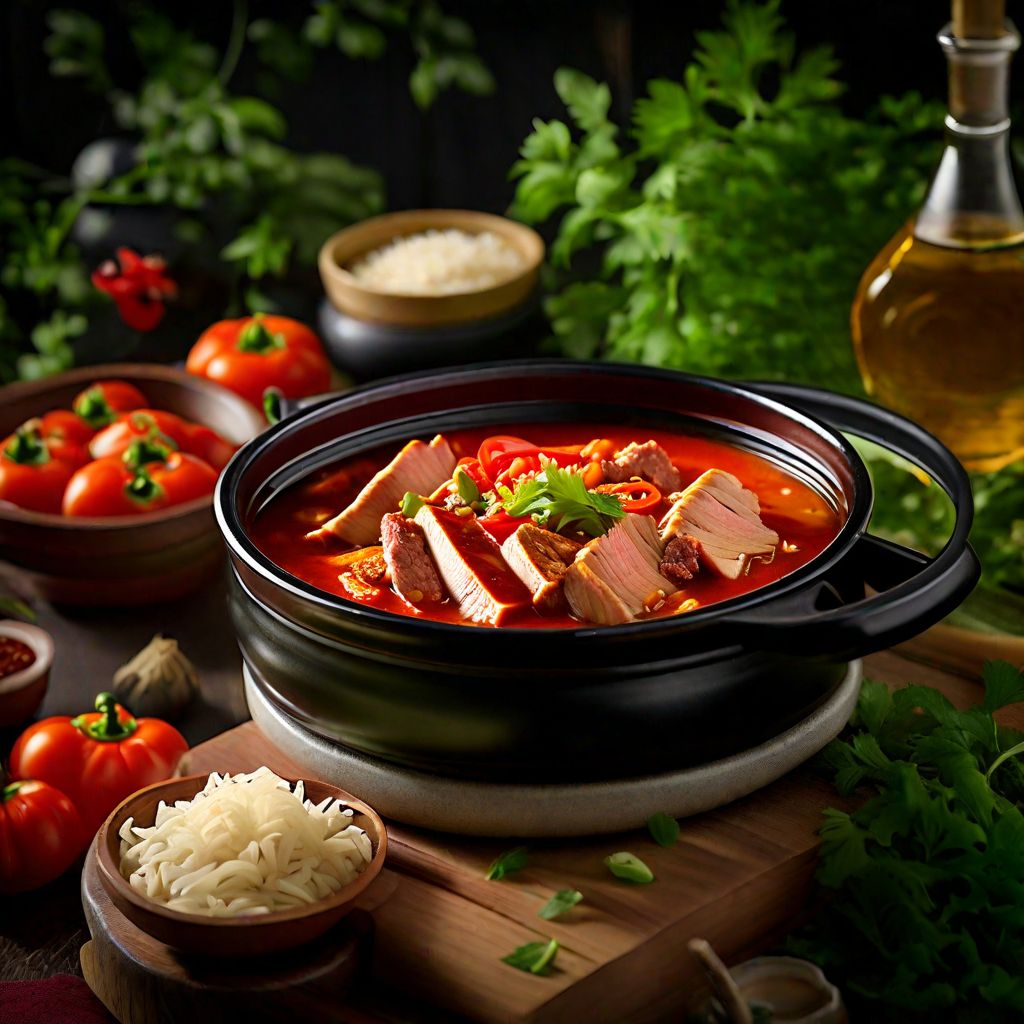
Recipe
Budae Jjigae (Turkish Style)
Spicy Turkish Army Stew
4.6 out of 5
In Turkish cuisine, Budae Jjigae, a popular Korean dish, is given a delightful twist. This spicy Turkish Army Stew combines the rich flavors of Korean cuisine with the vibrant spices of Turkish cuisine. It is a hearty and comforting dish that will warm your soul and satisfy your taste buds.
Metadata
Preparation time
20 minutes
Cooking time
25 minutes
Total time
45 minutes
Yields
4 servings
Preparation difficulty
Medium
Suitable for
Omnivore, Gluten-free, Dairy-free, Nut-free, Low-carb
Allergens
Soy, Wheat
Not suitable for
Vegan, Vegetarian, Paleo, Keto, Halal
Ingredients
While the original Budae Jjigae is known for its fusion of Korean and American flavors, this Turkish adaptation infuses the stew with traditional Turkish spices and ingredients. The result is a unique blend of flavors that pays homage to both cuisines. We alse have the original recipe for Budae jjigae, so you can check it out.
-
200g (7 oz) beef, thinly sliced 200g (7 oz) beef, thinly sliced
-
200g (7 oz) chicken, thinly sliced 200g (7 oz) chicken, thinly sliced
-
100g (3.5 oz) Turkish sausage, sliced 100g (3.5 oz) Turkish sausage, sliced
-
100g (3.5 oz) Turkish salami, sliced 100g (3.5 oz) Turkish salami, sliced
-
200g (7 oz) tofu, cubed 200g (7 oz) tofu, cubed
-
1 onion, sliced 1 onion, sliced
-
2 cloves garlic, minced 2 cloves garlic, minced
-
2 tablespoons Turkish red pepper paste 2 tablespoons Turkish red pepper paste
-
1 tablespoon tomato paste 1 tablespoon tomato paste
-
2 tablespoons soy sauce 2 tablespoons soy sauce
-
1 tablespoon gochujang (Korean chili paste) 1 tablespoon gochujang (Korean chili paste)
-
1 tablespoon olive oil 1 tablespoon olive oil
-
4 cups (950ml) chicken broth 4 cups (950ml) chicken broth
-
2 cups (470ml) water 2 cups (470ml) water
-
1 cup (150g) kimchi 1 cup (150g) kimchi
-
1 cup (100g) sliced mushrooms 1 cup (100g) sliced mushrooms
-
1 cup (100g) sliced carrots 1 cup (100g) sliced carrots
-
1 cup (100g) sliced zucchini 1 cup (100g) sliced zucchini
-
1 cup (100g) sliced bell peppers 1 cup (100g) sliced bell peppers
-
2 green onions, chopped 2 green onions, chopped
-
Salt and pepper to taste Salt and pepper to taste
Nutrition
- Calories (kcal / KJ): 350 kcal / 1465 KJ
- Fat (total, saturated): 18g, 6g
- Carbohydrates (total, sugars): 15g, 5g
- Protein: 30g
- Fiber: 4g
- Salt: 2g
Preparation
-
1.Heat olive oil in a large pot over medium heat. Add the beef and chicken slices, and cook until browned.
-
2.Add the Turkish sausage, salami, onion, and garlic to the pot. Sauté until the onion is translucent.
-
3.In a small bowl, mix together the Turkish red pepper paste, tomato paste, soy sauce, and gochujang. Add this mixture to the pot and stir well.
-
4.Pour in the chicken broth and water. Bring the stew to a boil, then reduce the heat and simmer for 15 minutes.
-
5.Add the tofu, kimchi, mushrooms, carrots, zucchini, and bell peppers to the pot. Cook for an additional 10 minutes, or until the vegetables are tender.
-
6.Season with salt and pepper to taste. Garnish with chopped green onions.
-
7.Serve the Spicy Turkish Army Stew hot with steamed rice or crusty bread.
Treat your ingredients with care...
- Turkish red pepper paste — Adjust the amount according to your spice preference. Add more for extra heat or reduce for a milder flavor.
- Turkish sausage and salami — Look for high-quality Turkish sausages and salami for the best flavor. You can also substitute with other types of spicy sausages if Turkish ones are not available.
- Gochujang — This Korean chili paste adds a unique depth of flavor and spiciness to the stew. If you can't find gochujang, you can substitute with a combination of chili powder and miso paste.
Tips & Tricks
- For a richer flavor, you can add a splash of Turkish red wine to the stew while simmering.
- Customize the vegetables according to your preference. You can add or substitute with other vegetables like potatoes, cabbage, or spinach.
- If you prefer a thicker stew, you can dissolve 1 tablespoon of cornstarch in water and add it to the pot during the last few minutes of cooking.
- Leftovers can be stored in the refrigerator for up to 3 days. The flavors will continue to develop, making it even more delicious the next day.
- Feel free to adjust the spiciness by adding more or less gochujang according to your taste.
Serving advice
Serve the Spicy Turkish Army Stew in individual bowls, accompanied by steamed rice or crusty bread. Garnish with chopped green onions for a fresh and vibrant touch.
Presentation advice
To make the dish visually appealing, arrange the sliced meats, tofu, and vegetables in an organized manner in the stew. The vibrant colors of the ingredients will make the dish look enticing and appetizing.
More recipes...
For Budae jjigae » Browse all
For Korean cuisine » Browse all
More Korean cuisine dishes » Browse all

Ssam
Ssam is a Korean dish that involves wrapping meat or vegetables in lettuce leaves and then dipping them in a spicy sauce. The dish is fresh,...

Bondipan
Meat and vegetable sandwich
Bondipan is a traditional Filipino bread that is made with coconut milk and sugar. It is a sweet and fluffy bread that is perfect for breakfast or...
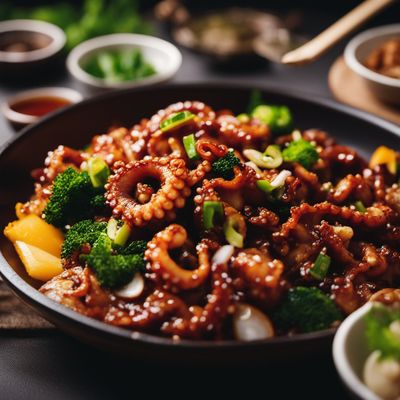
Nakji bokkeum
Spicy Octopus Stir-Fry
Nakji bokkeum is a Korean dish made with stir-fried octopus and vegetables. It is a spicy and flavorful dish that is often served with rice.
